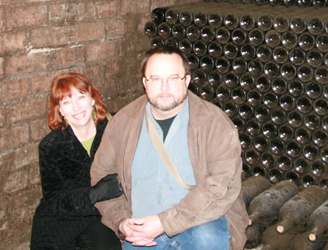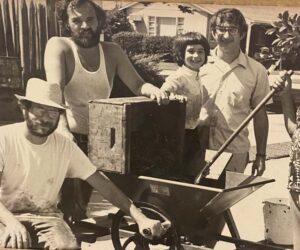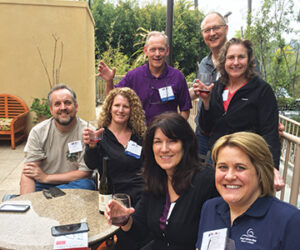
Joy Neighbors and her husband Brian
“Stop the press!”
It’s a phrase any journalist over the age of 40 still longs to hear. You can just picture the dusty newsroom, cigarette smoke hanging thick in the air; reporters hunkered over their typewriters, clacking out stories. Unfortunately for this former reporter, the first time I heard the heart-stopping phrase was not because we were breaking a hot story. No, we were breaking a press. A wine press!
Back in 1999, I and my husband, Brian, decided to leave the “big city” of Cincinnati, after many years in the media and printing industries, respectively, to try our luck with wine. Brian and his father, Ken, had won over fifty awards for their amateur wines within a five-year period. All signs pointed to going commercial. So we did.
We moved back to the family farm near Birds, Illinois, where Brian grew up. For a year, Brian, with assistance from his dad, created and crafted wines. But not just any wines. In other words, not just grape wines. No, Brian likes a challenge, so he decided on fruit wines — local fruit wines. Now many of you may know from experience that some fruits don’t really want to become wine. They lend themselves more to becoming jams, or jellies, or pies, anything thick, sweet and sticky. So when Brian decided local fruits could be a challenge, he immediately upped the ante by deciding that wild, local fruits like persimmons, paw paws and elderberries, would be the true test of his winemaking ability.
While I developed the public relations and marketing plan, and started the buzz about our winery, Brian began experimenting with the fruits. First, he had to decide which fruits he wanted to work with. When you’re crafting a new wine, you’d better be working with a fruit you like because you’re going to be spending a lot of time with it, getting to know it, learning how to coax out certain flavors, striking the correct balance between not too dry and not too sweet. It just takes a whole lot of finessing to make a well balanced, complex and enjoyable fruit wine.
After spending the summer locating, picking, sorting, crushing, pressing and fermenting elderberries, blueberries, rhubarb and blackberries, Brian decided that persimmons would be the fruit for autumn’s winemaking experiment.
If you are not familiar with a persimmon, it’s a distinctively American fruit. The greatest abundance of trees are found in the Mississippi River Valley, growing mainly in the wild. They can be identified by their black alligator-skin bark. Persimmons are a burnt orange color with a savory, unique flavor, if harvested when ripe. The American Indians called them the “fruit of the gods.” Persimmons are commonly used to make persimmon pudding, cookies, cake and bread, popular Thanksgiving meal staples in our area.
To gather persimmons, we went out into the woods and harvested them ourselves. While this was a fun way to spend an autumn afternoon, it wasn’t feasible to get enough persimmons in to make wine. After a few phone calls, we had friends and foragers tramping through the woods of Indiana and Illinois, searching for the perfect, ripe fruits. When a load of persimmons showed up at the winery door, we would process them just like grapes, cleaning, sorting, crushing and pressing them. And therein lay the problem.
Grapes are easy to press. So are elderberries, blueberries — any thin skinned fruit is, relatively, easy. Persimmons appeared to be the same. On this busy afternoon, with many extra hands involved, it still appeared to be going smoothly. Brian was busy overseeing the process, all the way from the arrival of the fruit to that satisfying splash as the pressed juice poured into the fermentation tank. He would pass by the press, check on the pressure being applied, give a tweak, if warranted, and move on.
And then, there was the awful sound of an explosion. Suddenly it was raining persimmon pulp — thick, sticky, gooey pulp! Everywhere you looked, the walls, the ceiling, the floor, everything within a 40-foot area was coated and dripping with that exotic smelling orange mush.
If you’re ever given the opportunity to help clean up after such an incident . . . RUN like the wind! It took almost eight hours of power washing to get the winery back in a useable condition. And another six months before we stopped finding stray pulp still clinging to the backs of wine tanks, stuck in the cracks and crevices of the walls, oozing out of ceiling seams and window casings.
We found out later what, or I should say who, caused the persimmon pulp explosion. It appears the old adage, “Too many cooks spoil the broth,” is very true. Only in our situation it was too many hands wanting to help by adjusting the pressure of the air bladder press.
But when life hands you persimmon pulp, it’s best to learn to make award-winning persimmon wine.
Joy Neighbors and her husband, Brian, own and operate White Owl Winery, which focus on wines made from local fruits. They started out as amateur winemakers making kit wines. Check out White Owl at www.whiteowlwinery.com.





